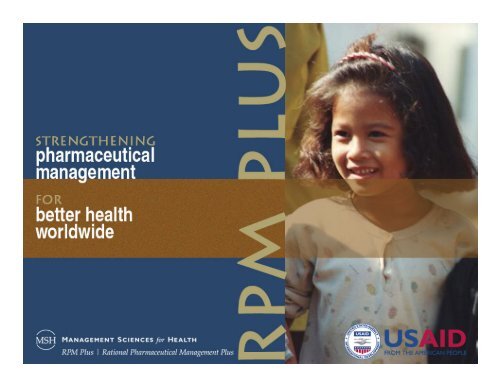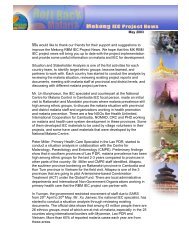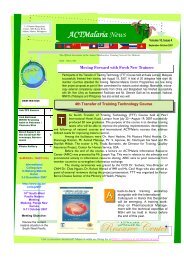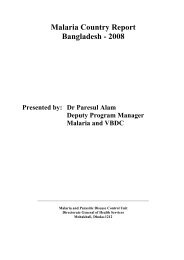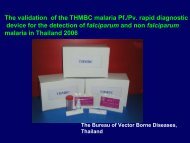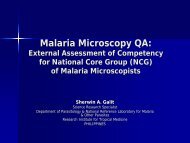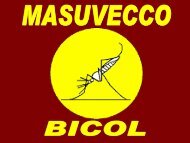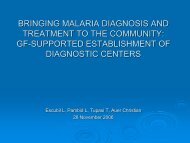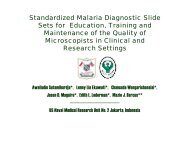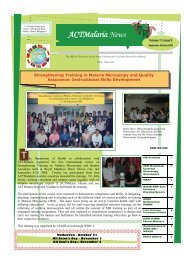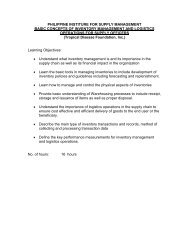Estimating Cost
Estimating Cost
Estimating Cost
Create successful ePaper yourself
Turn your PDF publications into a flip-book with our unique Google optimized e-Paper software.
Pharmaceutical<br />
Management and<br />
Quantification for Antimalaria<br />
Medicines<br />
Discussion Forum<br />
August 12—September 9, 2008<br />
Session 5.<br />
<strong>Estimating</strong> <strong>Cost</strong>s of<br />
Procurement
Objectives<br />
• Identify sources of price information<br />
• Project costs for quantities of medicines<br />
obtained during a quantification process<br />
• Apply the concepts of ABC and VEN analysis<br />
for reducing cost<br />
• Adjust quantities of medicines according to<br />
budget<br />
• Understand price comparison analysis
Session Outline<br />
• Sources of prices for antimalarial medicines<br />
• Projected costs<br />
• Adjusting for quantities<br />
• ABC analysis<br />
• VEN analysis<br />
• Price comparisons
Sources of Price Information<br />
• Roll Back Malaria Sources and Prices of<br />
Selected Products for the Prevention,<br />
Diagnosis and Treatment of Malaria<br />
• MSH International Drug Price Indicator<br />
Guide<br />
• UNICEF<br />
• Central Medical Stores<br />
• Internet<br />
• Others
Projecting <strong>Cost</strong>s (1)<br />
• List all items to be purchased and<br />
enter the unit cost<br />
• Enter consumption/estimated<br />
quantities<br />
• Calculate the value of each item
Projecting <strong>Cost</strong>s (2)<br />
Medicine<br />
Unit<br />
Dosage<br />
<strong>Cost</strong> per<br />
Unit<br />
(USD)<br />
Number<br />
of Units<br />
per<br />
Month<br />
Total<br />
<strong>Cost</strong><br />
(USD)<br />
Artesunate<br />
Tab<br />
50 mg<br />
0.07<br />
16,800<br />
1,176<br />
Sulfadoxinepyrimethamine<br />
(SP)<br />
Tab<br />
500/25 mg<br />
0.07<br />
2,100<br />
147<br />
Quinine<br />
Tab<br />
300 mg<br />
0.10<br />
2,100<br />
210<br />
Total<br />
1,533
Approaches to Adjusting Quantities<br />
to Procure<br />
• Equal misery approach<br />
• Estimate percentage shortfall and reduce all<br />
quantities by that percent<br />
• Preferential weighting approach<br />
• Use method(s) for giving weights to individual<br />
items and reduce quantities accordingly
Equal Misery Approach (1)<br />
• Total budget available: USD 14,500<br />
• <strong>Cost</strong> of total requirements: USD 18,396<br />
• Percentage shortfall: 21.18%<br />
• Reduce quantities of all items by 21.18%
Equal Misery Approach (2)<br />
Medicine<br />
Number<br />
of Units<br />
Annually<br />
Quantity to<br />
Reduce by<br />
(21.18%)<br />
Reduced<br />
Total<br />
Quantity<br />
<strong>Cost</strong><br />
per Unit<br />
(USD)<br />
New <strong>Cost</strong><br />
(USD)<br />
Artesunate<br />
201,600<br />
42,696<br />
158,904<br />
0.07<br />
11,123<br />
SP<br />
25,200<br />
5,337<br />
19,863<br />
0.07<br />
1,390<br />
Quinine<br />
25,200<br />
5,337<br />
19,863<br />
0.10<br />
1,986<br />
Total<br />
14,500
Preferential Weighting Approach<br />
• Make intelligent decisions about<br />
• Which medicines to procure<br />
• Quantities of various medicines to<br />
procure<br />
• Use tools such as<br />
• ABC analysis<br />
• VEN analysis
ABC Analysis (1)<br />
• Method of classifying medicines by rate of use<br />
and cost within a health facility or system<br />
• Assembles data from recent or projected<br />
procurements to determine where money is<br />
actually being spent<br />
• Allows managers to focus first on high-cost<br />
items when considering ways to reduce<br />
procurement costs
ABC Analysis (2)<br />
A<br />
B<br />
C<br />
High percentage of funds spent on largevolume<br />
or high-unit-cost items; great<br />
potential for savings (75%)<br />
Fewer funds spent on larger numbers of<br />
these items; savings are possible (15%)<br />
Few funds are spent on the majority of<br />
inventory; savings are possible, but at high<br />
cost (10%)
Performing an ABC Analysis<br />
1. List all items to be purchased/consumed and enter<br />
the unit cost per item<br />
2. Enter consumption/estimated quantities<br />
3. Calculate the value of each item<br />
4. Calculate the percentage of total value represented<br />
by each item<br />
5. Sort the list in descending order by total value<br />
6. Calculate the cumulative percentage of total value for<br />
each item<br />
7. Choose cut-off points for A, B, and C classes
Adjustments Based on ABC<br />
Classification<br />
• Set procurement period based on ABC<br />
classification of item<br />
• Example<br />
• Class A:<br />
• Class B:<br />
• Class C:<br />
6 months<br />
9 months<br />
12 months
Example<br />
Medicine<br />
Number<br />
of Units<br />
Annually<br />
<strong>Cost</strong> per<br />
Unit<br />
(USD)<br />
Value<br />
(USD)<br />
New<br />
Procurement<br />
Period<br />
Reduced<br />
Total<br />
Quantity<br />
New<br />
<strong>Cost</strong><br />
(USD)<br />
Artesunate<br />
201,600<br />
0.07<br />
14,112<br />
6<br />
100,800<br />
7,056<br />
SP<br />
25,200<br />
0.07<br />
1,764<br />
9<br />
18,900<br />
1,323<br />
Quinine<br />
25,200<br />
0.10<br />
2,520<br />
12<br />
25,200<br />
2,520<br />
Total<br />
18,396<br />
10,899<br />
Budget available: USD 14,500
VEN Classification<br />
V Vital: potentially lifesaving: significant<br />
withdrawal side effects; crucial to providing<br />
basic health services<br />
E Essential: effective against less-severe but<br />
significant illnesses, but not vital<br />
N Nonessential: for minor or self-limited<br />
illnesses; of questionable efficacy; or high<br />
cost for marginal therapeutic advantage
Adjustments Based on VEN<br />
Classification<br />
• Adjust safety stock period based on VEN<br />
classification<br />
• Example<br />
• Class V: 3 months<br />
• Class E: 1 month<br />
• Class N: 0 months<br />
• Apply varying adjustment percentage based on<br />
VEN classification<br />
• Example<br />
• Class V: 100%<br />
• Class E: 50%<br />
• Class N: 0%<br />
• Identify and limit therapeutic duplications
Price Comparisons<br />
• Prices must refer to same year<br />
• Use same generic products in the same or<br />
comparable dosage forms, strength, and<br />
units<br />
• Adjust for different INCOTERMS<br />
• FOB (Free on Board)<br />
• CIF (<strong>Cost</strong>, Insurance, and Freight ): Landed<br />
cost<br />
• Clearing, handling, and storage charges
Compare Public and Private Sector<br />
Prices<br />
• Public sector prices may be compared against<br />
purchase and selling prices of the private sector<br />
• Wholesale and/or retail prices may be compared<br />
• Survey required to obtain price information
Summary<br />
• Project your costs<br />
• Adjust cost for quantities<br />
• Set expense priorities based on ABC and<br />
VEN analysis<br />
• Price compare


